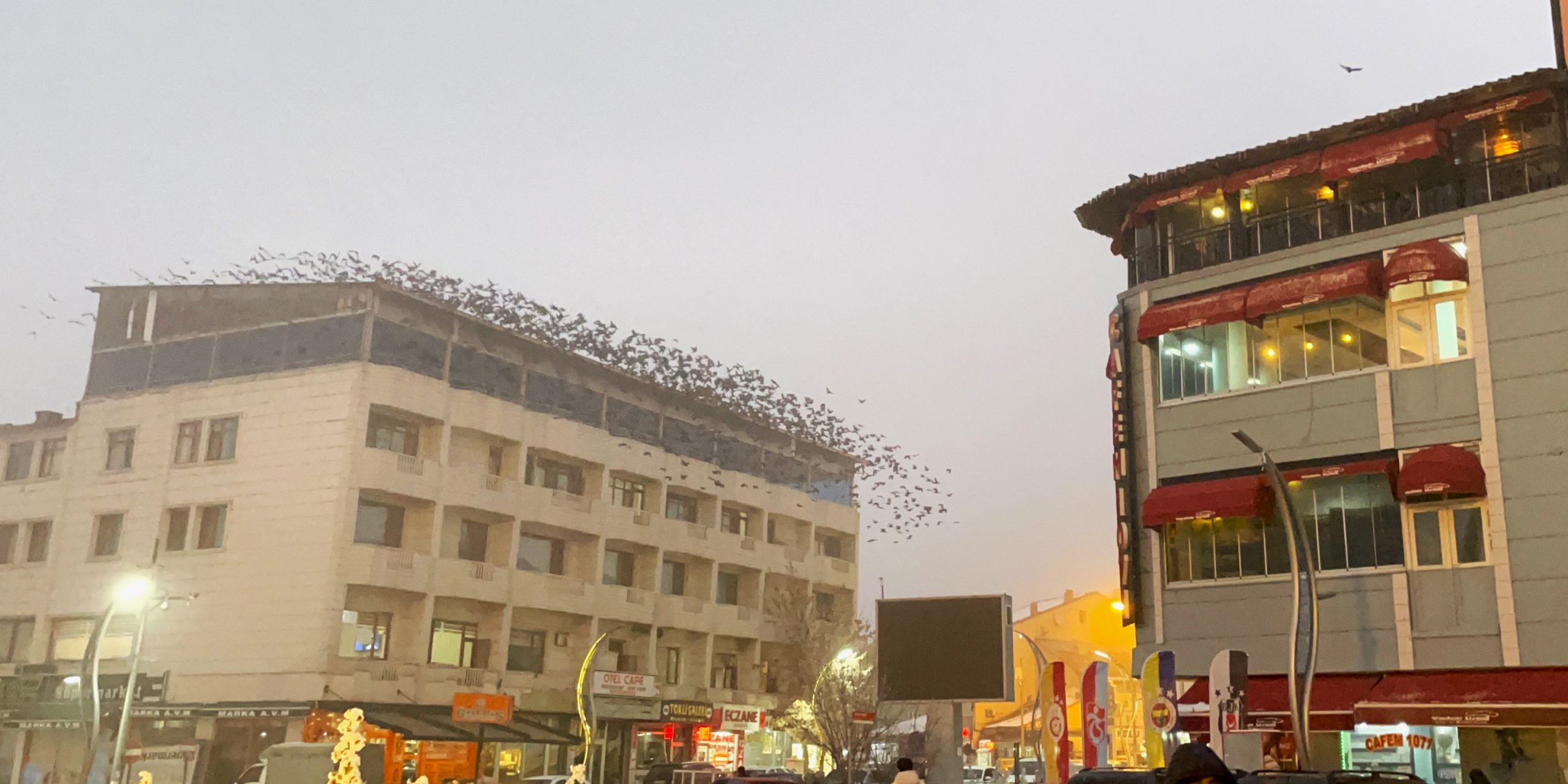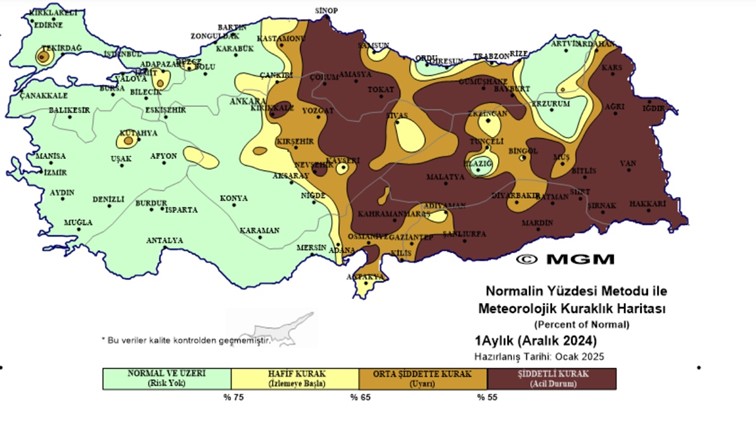Climate crisis hinders bird migration routes: Birds remain in Anatolia during winter
In Malazgirt, milder winters and delayed snowfall are disrupting traditional migratory routes, forcing thousands of birds to seek refuge in the town during sudden snowstorms.
07.03.2025
In Eastern Anatolia, winters have undergone a profound transformation. Locals attest that the once biting cold and heavy snows that blanketed villages and districts are now a relic of the past. This unmistakable climatic shift is unmistakenly altering the migratory routes of birds in Malazgirt.
Nestled in a magnificent plain stretching from the rugged foothills of Mount Süphan to the shimmering expanse of Lake Van, Malazgirt is a historic and picturesque town in eastern Turkey. In recent winters, it has become a haven for migratory birds. Yet when sudden frosts sweep the region, these birds struggle to find sufficient food and shelter. During heavy snowfall, they seek refuge in the town center among the trees. As they gather, the branches become adorned with their dark, fluttering silhouettes, transforming the landscape into a striking tapestry reminiscent of leaves cloaked in shadows.
Tahsin Kılıç, the president of the local Chamber of Agriculture and an expert on the environment and wildlife in Malazgirt, has observed a link between disrupted bird migration patterns and changing climate conditions. “Historically, our district did not host such large numbers of birds. However, in recent years, especially during winter, we have observed a significant increase in birds becoming stranded in the area,” he noted.
Kılıç’s recent observations underscore how rising winter temperatures and diminished snowfall have disrupted the natural migratory rhythms of birds. Notably, species such as crows, drawn by these warmer conditions, are increasingly choosing to remain in the region during winter. As temperatures drop, these birds seek refuge in towns and nearby villages, while in the summer they forage the plains for sustenance, often relying on loose grains of barley and wheat. This behavior serves as a clear signal of profound ecological change.
“The erratic temperature fluctuations of recent years have complicated thee journeys of migratory birds, misleading many and causing delayed departures.”
Sudden temperature plunges, however, pose a serious risk. Crows, perpetually in flight in search of food and flitting from roof to roof, encounter particular difficulties when the ground is blanketed by snow.
Journalist, environmental activist, and keen birdwatcher Azadi Özkahraman has also noted an unprecedented variety of bird species in Malazgirt compared to previous years. He remarked that thousands of birds now traverse the winter skies – a rarity in the past. “In winter, snowfall has been notably low, which in turn affects the timing of bird migrations. The erratic temperature fluctuations of recent years have complicated their journeys, misleading many and causing delayed departures. Presently, one can observe thousands of birds soaring above the town center,” he explained.
This year, an unusual shift in winter temperatures has disrupted the migratory routes of various bird species on the Muş Plain, west of Malazgirt. With the sudden onset of cold, numerous waterfowl —storks, grebes, little grebes, little egrets, great egrets, spoonbills, and grey herons— have sought refuge in Muş’s central areas, underscoring the profound impact of climate change on avian behavior and habitat needs during migration.
Özkahraman observed, “Climate change poses a significant threat not only to humanity but to all wildlife. As adapting to these changes grows ever more challenging, we must reflect on our situation and assume greater responsibility for environmental protection.”

Photo: Veysel Eşin
The expansive wetlands of the Malazgirt and Muş plains provide abundant nourishment for birds. Speaking to journalist İbrahim Yaldız, Kasım Avcı, president of the Muş Telli Turna (demoiselle crane) Environmental Protection Association, explained that when the ground is cloaked in snow, many birds migrate to warmer regions. “There are species that typically do not migrate, or only partially do so, yet this year we are witnessing a marked increase in these species due to the mild weather. Contributing factors include the area’s rich natural resources, abundant food, and its strategic location along major migration routes,” he noted. He added, “These conditions create an ideal environment for birds to seek shelter and breed. This winter has felt more like spring, which is why we are observing such a remarkable diversity of bird species.”
Delayed rain and snowfall increases risk of drought
The impact of above-average seasonal temperatures and late snowfall is not limited to disruptions in birds’ migration patterns. It also results in less water being available in the region.
According to Tahsin Kılıç, this poses a significant risk of drought. Kılıç said, “In previous years there was enough snow accumulating in the mountains and highlands to feed our water resources when it melted in the spring. However, the lack of adequate snowfall in recent years has caused lower water reserves in the mountains.” In springtime, the plains of Malazgirt and Muş turn green. Melting snow on the mountains surrounding the plains flows into rivers to feed the water resources used by the local people and agricultural producers. According to Kılıç, “Lower precipitation makes it very challenging to meet the clean water needs of people in the district center and to maintain the water level in reservoirs.”
Drought data and maps produced by the State Meteorological Service show that the plains of Malazgirt and Muş have experienced medium and severe drought periods in recent years. The Drought Conditions Map for December 2024 shows that Eastern Anatolia has received 55 percent or less precipitation than normal. The data help explain why birds stay in the plains during the winter.

This map shows the drought conditions in Turkey for December 2024, with dark brown representing severe drought and light brown indicating medium drought conditions. Source: Turkey’s State Meteorological Service
The impact of unusually high seasonal temperatures and delayed snowfall extends beyond disrupted bird migrations. It also reduces regional water availability.
Tahsin Kılıç noted a significant drought risk due to declining snowfall. “In past years, ample snow would accumulate in the mountains and highlands, replenishing water resources in spring as it melted. However, in recent years, insufficient snowfall has led to diminished water reserves,” he explained. Each spring, as melting snow nourishes the rivers, the plains of Malazgirt and Muş turn green, supplying essential water to local residents and agricultural producers. “Reduced precipitation severely hampers efforts to meet the district center’s clean water needs and to maintain reservoir levels,” Kılıç further said.
“When precipitation falls short, stress on existing water resources mounts, triggering a cascade of ecological issues.”
Data from the State Meteorological Service reveal that the Malazgirt and Muş plains have experienced medium to severe drought conditions in recent years. The December 2024 Drought Conditions Map indicates that Eastern Anatolia has received only 55 percent or less of its normal precipitation, which partly explains why birds linger in these plains during winter.
Kılıç stressed the urgency of addressing water scarcity. “Climate change is impacting every facet of our lives,” he said. “To ensure sustainable agricultural production, we must enhance irrigation efficiency, safeguard water resources, and support our farmers. Failure to act endangers both agricultural output and local wildlife.”
Following the extraordinarily dry winter of 2022–2023, a report entitled the “Climate and Drought” by the Doğa (Nature) Association –a partner of BirdLife International– calls for a comprehensive policy to address consistently above-average winter temperatures. Prepared by Mehmet Kaya, the report attributes the current meteorological drought to a general rise in average temperatures, a decline in precipitation since 2019, and below-average rainfall. Notably, summer 2022 ranked as the eighth warmest season in 52 years and autumn 2022 as the sixth, both marked by deficient precipitation.

Photo: Veysel Eşin
The report warned that extraordinary temperatures and droughts may soon become the norm, urging authorities to adopt innovative strategies, especially in agricultural water management. “When precipitation falls short, stress on existing water resources mounts, triggering a cascade of ecological issues. Under these circumstances, water management must be approached as a crisis, with a long-term, sustainable strategy. Moreover, adopting a rights-based approach is essential, as water is a fundamental right for all living beings and ecosystems,” it said.
In Eastern Anatolia, birds are deeply woven into local life, with cranes standing as potent symbols of abundance. Their decision to remain in town centers rather than migrate signals a disruption of nature’s delicate balance, a shift that portends a decline in the richness essential to the community’s well-being.
This article was published as part of a program supported by the UK Ankara Embassy’s Bilateral Cooperation Programme. The content of this article is solely the responsibility of P24. The UK Embassy cannot be held liable for the information provided in this article.

